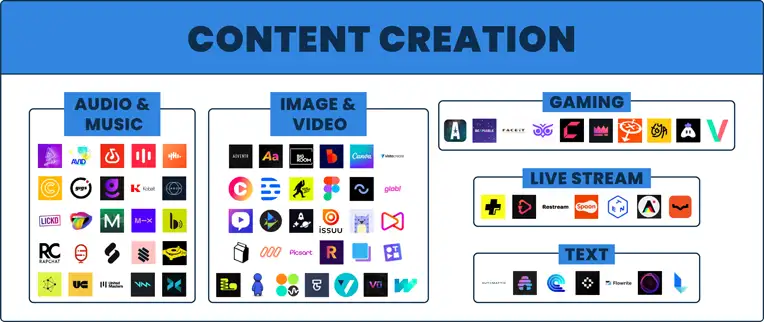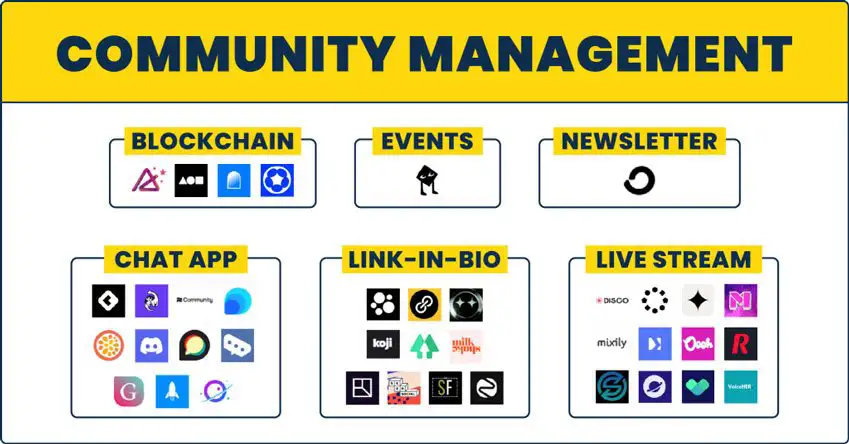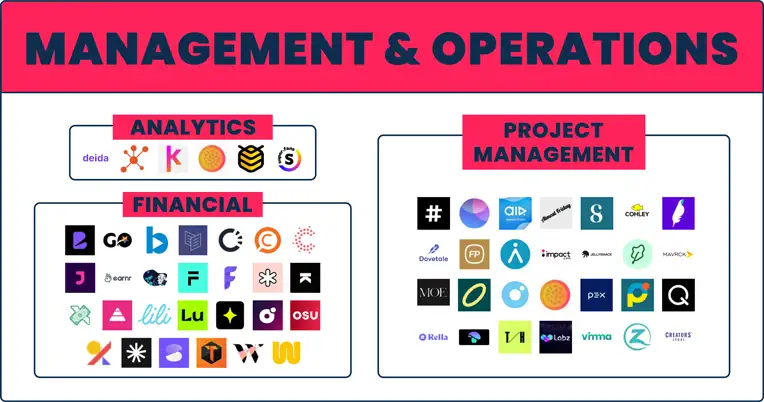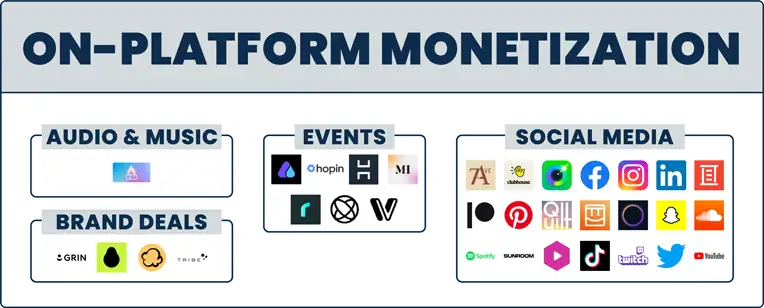What is the creator economy?
You will find many definitions of what the creator economy is. Most will say that it’s a class of businesses centered around creators making a living from what they love most: content creation.
Of course, they walk side-by-side with creator economy companies that empower creators to grow and monetize.
The creator economy is closely tied to the content economy and passion economy. People have been creating content out of passion since the beginning of time.
What’s different now is the career opportunities, professional fulfillment, and multiple ways of making money that content creation provides.
I’m not gonna go too deep into this as we have other more important topics to cover today but you can find everything you need to know about the creator economy 👈 over here.
How did the creator economy become what it is today?
First, I have to mention the advancement of technology. It’s directly tied to the rise of the creator space and escalated its evolution. Better computers, laptops, smartphones, cameras, and faster Internet.
The Internet gave birth to ✨social media✨, and social media then gave birth to the creator economy. It created a space where independent creators can express themselves authentically and earn money while doing it. No more generic content dedicated to the needs of companies.
With this growth came the need for tools and services that enable creators to do their job to the best of their abilities. Not just in regards to content but also specific tools for managing finances, community platforms, selling services, etc.
A deep dive: the Creator Economy market map

According to our database, there are over 300 creator-focused startups in the creator economy.
They include:
- Content creation tools;
- Community management;
- Management & operations;
- On-platform monetization;
- Off-platform monetization.
- Legal
Keep in mind that some of these platforms and creator tools overlap, as one can fall into multiple categories. For example, Linktree is a monetization platform, but it’s also a community management platform.
Brace yourself as we go through all these tools that make up the creator economy market map one by one.
Content creation tools

Companies that fall in this category offer tools that help creators produce and edit content, including text, images, videos, audio, live streams, and games. And in my opinion, it’s one of the most important categories for empowering creators to do what they do best.
Text
These tools offer different options for text content, including blog articles, poems, copy, etc.
Ghost is an open-source blogging platform for creators that are designed to make the process of online publishing for creators smoother and more profitable.
Images & Videos
Tools for image & video creation are probably the most prominent creator tools in this category. There are loads of platforms, tools, and software to choose from.
One cult favorite (and my personal favorite) is Canva, a platform that provides user-friendly tools for creating good-looking visual content for various needs.
Audio & Music
The demand for audio content has been on the rise, and thus, the birth of many audio platforms.From podcast platforms, like Red Circle, a platform that offers distribution, promotion, and monetization of podcasts, to platforms like Thematic, a platform that offers creators copyright-free music for their video content.
Live stream
Live streams are a big component of the creator-audience interaction. It brings the audience closer to the creator and makes them feel like they joined along for the ride.
Live streaming is nothing new but what’s new are the new tools that make live streaming a lot more interactive and fun. For example, StreamAlive provides tools like live chats, live voting polls, etc. to make the whole experience more interactive.
Games
There’s a wide range of gaming tools to choose from. Highlight creation, social gaming, mobile-first, gaming coaching, you name it. There are loads of platforms to choose from.
For example, Splash developed a Roblox game for creators to make and share music with virtual audiences. Another one is RecRoom, a social gaming platform.
Community management platform

Community management platforms have never been more important in the creator space.80% of founders reported that building a community is important for their business. As the creator economy grows, creator-led digital communities are popping up everywhere. They empower and support creators whilst enjoying their favorite content.
When a creator has an established audience, they next want to migrate them to a community management platform. These platforms allow creators to own communities, offer them exclusive content, and engage with their developed fandoms in a more personal way.
Discord, for example, is an amazing platform for building communities that’s super simple to use.
With that being said, let’s take a look at the community management platforms by category.
Chat Apps
Chat apps have evolved from exchanging messages back and forth with close friends to building communities of thousands and millions of fans. They’ve become a key component in maintaining a loyal community so it’s no wonder creators have utilized these tools.
Some worthy mentions: WhatsApp, Telegram, Discord, Viber, etc.
Link-in-bio
Link-in-bio tools revolutionized the way creators display their products and manage their communities. You can have your social media channels, storefronts, products, and contact information all in one customizable landing page with links.
I’m sure you’ve already heard of some of these: Linktree, Milkshake, Direct.me, etc.
Live stream
An important component of any community is interaction, and live streams are a great way to interact with an audience online in real time.
For example, SuperGreat is a beauty community platform where creators can share real experiences with different beauty brands through live streaming. And need I mention the most famous live-streaming platform? Twitch.
Newsletter
Newsletters are great for community builders as it offers value to the audience while also keeping them engaged. ConvertKit is one of the better-known ones, but there are tons of tools that offer the same or similar services.
Blockchain
Even though blockchain technology is at a relatively early stage of its development, it’s not just some digital trend anymore. It has decentralized big-name platforms and offered creators complete ownership of their content, and a new revenue stream without having to rely on platforms.
Using blockchain for building communities, creators can offer their audience ownership over content pieces, grant them access to exclusive content, and give them discounts for products and services they provide.
For example, Unlock is a platform for creators to build communities and allow fans access to exclusive memberships and content based on NFTs.
Management & Operations

In order for creators to operate as businesses, creators need platforms to plan, organize and manage their business activities. These include finances, daily operations, analytics, and projects.
Finances
This category of start-ups has been one of the fastest-growing in the creator economy. There are loads of financial tools for creators aimed at solving different financial problems, like payment tracking and managing revenue streams.
Karat, for example, offers credit cars exclusively for creators.
Analytics
Data-driven decisions are very important for creators as they allow them to take the next step based on trends and analytics, rather than assumptions. Many of the tools in this category, as well as other categories, offer analytics for different purposes.
For example, VidIQ is a YouTube-focused platform that offers analytics and recommendations for increasing the view count on YouTube videos.
Project management
Creators usually have to tackle multiple projects at once so having tools that help them manage them is really beneficial. Like Moe, a project management tool for influencers that helps them create projects, get feedback from their clients, create invoices, and get paid faster.
On-platform Monetization

Social media platforms
This category is the motherload of all platforms. Social platforms gave birth to the creator economy we know and love today. I don’t even need to mention them but I will anyway:
- YouTube and Twitch – long-form videos and live streams;
- Snapchat, Instagram, and TikTok – photos and short-form videos;
- Facebook and LinkedIn – multimedial social platforms
- Pinterest – photo-sharing platform;
- Twitter – mostly short-form text content;
- Medium – long-form text content, blogging;
- SoundCloud, Spotify – audio and music;
Just to name a few. These platforms are the main drivers of growth for creators and social media influencers.
Brand deals
Companies in this category are basically marketplaces that connect creators with brands they want to collaborate with. These platforms serve both creators and brands to find their match for future collaboration projects. Brand deals are the top revenue stream for creators so these platforms hold great importance.
Well-funded companies in this category include CreatorIQ and Grin, which offer a full suite of services for managing large-scale influencer campaigns.
Events
Platforms for hosting paid events exploded with the rise of the pandemic but they’re not going back into the shadows any time soon. It’s fast, simple, convenient, and cost-effective.
For example, Airmeet is an online venue for events, summits, and conferences. It gives the users the ability to attend virtual events, attend sessions, and make new connections from anywhere they are.
Off-platform Monetization

Aside from on-platform monetization, creators can maximize their earnings by diversifying their revenue streams. Platforms usually take a percentage of creators’ earnings and their revenue shares change over time. That’s not the most reliable way for creators to earn money.
Monetizing off-platform offers creators more control and reliability of their earnings. Let’s take a look at what these platforms are.
Memberships & Subscriptions
These are some of the most used platforms in the creator space. They were popular before but they experienced astronomical growth through the Pandemic. Here fans can pay creators for exclusive content and memberships in private groups.
I’m sure you know some of these platforms. Patreon, OnlyFans, Substack, By me a Coffee, etc.
E-commerce
E-commerce is a crucial part of most creator businesses.If you want to sell any kind of physical good, you need an e-commerce platform to do so. And I’m not talking about merch (more on that in the next section), I’m talking about physical goods that creators make themselves: accessories, pottery, notebooks, and so on.
Many creator platforms offer e-commerce services and have integrations with some of the biggest e-commerce platforms in the space. Some are Shopify, Magento Ecommerce (now Adobe Commerce), BigCommerce, Popup, etc.
Digital Products & Merch
Companies provide creators with a wide variety of services with the goal to sell digital or physical merchandise. Manufacturing, printing, distribution, branding, etc. That way, creators don’t have to build their own supply chains, the companies do it for them.
Companies like Spring, and Printify have a range of products to choose from, like clothes, phone cases, and custom prints. On the other side, Creative Fabrica is the place where digital creators sell different fonts, crafts designs, graphics, and other premium content.
Courses
Courses are a great way for independent creators to share their expertise, educate, and of course, monetize. These platforms offer courses, classes, coaching sessions, etc., and support through the launch process, sales analytics, and scheduling.
If you’ve ever bought a course you’re probably familiar with some of these platforms, like Skillshare and Kajabi.
Fan interactions
Platforms in this category offer fans the chance to help their favorite creators earn money through personalized interactions and video shoutouts. Cameo is the leading app in this category, allowing creators and celebrities to sell their interactions. Another one is NewNew, where fans can pay to vote on the decisions of creators.
Blockchain
Blockchain platforms not only provide creators with one more revenue stream but have complete ownership over their content, money, and fan base. Examples of this category are OpenSea and Rarible, platforms that let creators create and mint NFTs.
Legal
The newest edition to the creator economy market are legal firms for creators.
Even though the creator space has existed for a while, it’s still in its infancy. There aren’t many laws set for creators, and contracts are a big part of the creator business, from brand collaboration contracts to music licensing & copyright protection.
Creators Legal is the first legal company for creators, providing documentation, organization, and generation of legal contracts. This way, creators can get themselves protected in minutes without the need for expensive lawyers.
Mapping out by location
It started with the US
The US is where it all started.
The USA is the home of the majority of the creators in so it’s no surprise that the creator economy exploded there first. This is fertile soil not only for creators but for platforms as well, with the majority of creator economy startups emerging here.
The effects of the creator economy on the national economy cannot be denied. YouTube’s creative ecosystem contributed $20.5 billion to the US economy in 2020 and supported 394,000 full-time equivalent jobs.
Asia is booming
The US is not the only country where the creator economy is booming anymore.
China
Today, China has a mature creator ecosystem. Its market size in 2021 was valued at $20 billion.
There are a couple of reasons why the creator space in China exploded the way it did. First, China’s social media platforms are mostly, if not all, mobile-first optimized and made for instant access and sharing.
Secondly, Chinese influencers offer a lot of real-time interaction, focusing on live streams and live online performances. That strengthens the influencer-audience relationship while providing entertainment. And the influencers get hefty rewards in return.
India
In India, the creator economy is expected to have a massive rise of creators joining the space in 2024. Indian creators are very diverse. From courses on social media growth and content creation to gamers, food bloggers, and beauty gurus.
“The creator economy in the country has the potential to emerge as a soft power impacting economic growth, job creation, and even cultural influence. As our creators and artists build the next generation of media companies that are connecting with a global audience, their impact on the economy’s overall success will only continue to accelerate,” said Ajay Vidyasagar, regional director, APAC, YouTube Partnerships.
South Korea
South Korea’s content market occupies 2.6% of the entire global content market, and it’s the 7th largest content creation nation, largely thanks to K-pop and K-dramas.
The South Korean government launched multiple financial measures in 2019, totaled at 1 trillion won (more than $782 billion), to help finance both content creators and content companies.
The measures include corporate-guarantee bank loans for small creators, a venture fund for financing high-risk, small-pocketed content creation projects, and driving up the number of medium-sized content companies.
“All government agencies will join hands to proactively help content creators fulfill their dreams and the Korean content market make a leap.”, said Culture Minister Park Yang-woo
Europe is next in line
The European creator economy is an important part of the bigger picture, with so many diverse languages, cultures, and backgrounds.
YouTube fosters 142.000 full-time jobs in countries of the EU and included €2.38 billion in the EU’s GDP. That is almost as much as the EU’s Creator fund. With over 29,000 channels with over 100.000 subs, and a 20% increase every year, these numbers are not surprising.
The number of creator economy startups and investments has also been on the rise. For example, Sorare, a French Web3-based startup raised $680 million with the goal to become the next entertainment giant, starting with soccer.
Let’s summarize
In today’s world, being a creator means being not only an artist but being an entrepreneur. Community management, data analysis, product design, and e-commerce all make up the modern creator archetype. As creators grow and expand in the audience, projects, and revenue streams, daily operations become complicated and hard to manage.
This is where creator economy startups come in.
Startups that focus on lessening the burden of the day-to-day activities of creators are the ones that will triumph.
All these things together made the creator economy become what it is today and empowered creators to share their content, monetize their creations, and build a recognizable personal brand for themselves.






